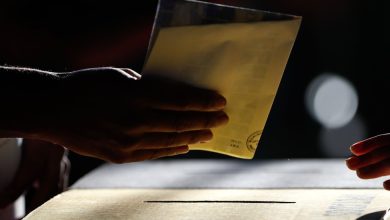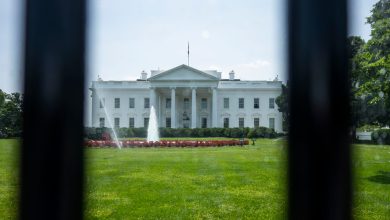Biden as a New F.D.R.? Try L.B.J.

Joseph R. Biden Jr. was supposed to be another Franklin D. Roosevelt, a Democratic president who enacted transformative liberal legislation and in doing so built a lasting political coalition.
It’s a comparison that he invited even before the election, when he told The New Yorker in an interview in August 2020 that he was “kind of in the position that F.D.R. was in.” Prominent presidential historians and even the descendants of F.D.R.’s cabinet members echoed the comparison.
One year into his presidency, no one is confusing Mr. Biden for Mr. Roosevelt. Not with his legislative agenda stalled and his approval rating mired in the low forties.
But the difference between the two Democrats isn’t merely the one between success and failure in the first year. Rather than following Mr. Roosevelt’s playbook and focusing relentlessly on the crises facing the nation and voters, Mr. Biden’s efforts have shifted from the pandemic and the economy to also pursue longstanding Democratic policy goals — universal prekindergarten, climate change, voting rights, a child tax credit.
Even if those proposals are needed or important, they do not rank high on the list of the public’s demands at the heart of a pandemic and with rising inflation. Only 33 percent of voters say the president is focused on the issues they “care a lot about,” according to a recent CBS/YouGov poll.
The decision to prioritize the goals of his party’s activist base over the issues prioritized by voters is more reminiscent of the last half-century of politically unsuccessful Democratic presidents than of Mr. Roosevelt himself.
It’s not so much Mr. Roosevelt’s New Deal as Lyndon B. Johnson’s Great Society. One launched an era of Democratic dominance; the other brought that era to its end.
It is a presidency aimed at matching Mr. Roosevelt’s transformative legacy while forgetting the most basic, high school history class lesson about the root of the New Deal’s political appeal: It was designed to meet the challenges of the moment.
While liberals cherish the New Deal for expanding the role of government, the core of its political success was its focus on addressing an immediate crisis facing the nation — the shuttered banks, failing farms and mass unemployment of the Great Depression. The New Deal was not always successful. Its individual provisions were not always popular. But Mr. Roosevelt fixed the banking crisis and quickly restored a sense of hope and optimism. Americans believed that his policies put them on the path to recovery. The expansion of government was incidental to its central political appeal.
Mr. Biden understood as much before the election, when he reminded The New Yorker that “what in fact F.D.R. did was not ideological, it was completely practical.”
Yet in a news conference on Wednesday, Mr. Biden strained to reframe his proposed package of liberal policy initiatives as a practical response to the pressing challenge of inflation.
Perhaps the history books will remember Mr. Biden for putting America on a path to normalcy. But Americans do not have that impression of the Biden administration today. More than half of voters think Mr. Biden is not focused enough on the economy or inflation, according to the recent CBS/YouGov poll.
The poll gave no indication that Mr. Biden’s legislative agenda would do much to improve his standing. Just 24 percent of voters said their opinion of Mr. Biden would improve if he passed the Build Back Better Act, even though a majority of voters say they support the proposal. In contrast, 70 percent said their opinion of Mr. Biden would improve if he tamed inflation, while 60 percent said it would improve if the coronavirus situation did.
Voters should not necessarily be taken at their word, but their message is consistent with a large body of political science research: The fortunes of the president are tied to the strength of the economy.
The comparison between Mr. Biden and Mr. Roosevelt is strained today, but it was plausible enough to some historians just a few months ago. Like Mr. Roosevelt, Mr. Biden faced a litany of crises that might be addressed with government action. And for the first six months of his presidency, one could draw a plausible parallel between Mr. Biden’s approach to the crisis and the early days of Mr. Roosevelt’s term.
Like Mr. Roosevelt’s First Hundred Days, the $1.9 trillion dollar Rescue Plan sought to offer relief from the pandemic and a path back to normalcy. It lacked the political appeal and psychological impact of Mr. Roosevelt’s blizzard of legislative acronyms, but it seemed to help put the nation back on the road to recovery, amid rising vaccination rates, plummeting case numbers and a surging economy.
The analogy does not hold so clearly anymore, not since the summer’s optimism gave way to the Delta variant, rising inflation, a chaotic withdrawal from Afghanistan and ultimately malaise. At the same time, Mr. Biden’s legislative agenda transitioned to longer-term, progressive policy goals. Many Democrats from across the ideological spectrum believed that popular legislative initiatives, from a bipartisan infrastructure bill to the wide-ranging social spending bill, would help the president improve his popularity. They have had no effect.
While the legacy of Mr. Roosevelt is often cited as the blueprint for building a political coalition with progressive legislation, there’s not much reason to believe his initiatives would have yielded political dominance if they did not have a clear connection to recovering from crisis and depression.
Public opinion data from the 1930s is fairly sparse, but there is only equivocal evidence that the public was ideologically inclined toward expanded government, organized labor or social democracy. The public supported many New Deal programs, but wanted Mr. Roosevelt to be “more conservative” by 1938. By then, nearly 40 percent of Democrats preferred a conservative Democrat to a New Dealer if Mr. Roosevelt did not seek a third term.
Indeed, Mr. Biden’s efforts today might be more reminiscent of Mr. Roosevelt’s second term, when the economy fell back into recession and Mr. Roosevelt unsuccessfully pushed a more liberal agenda. The result was the formation of the so-called “conservative coalition” of Republicans and anti-New Deal Southern Democrats. The New Deal had come to an end.
The Biden administration does appear to recognize the disconnect between the aims of its agenda and the demands of the public. At his news conference on Wednesday, Mr. Biden was generally focused on the coronavirus and inflation. But his legislative agenda remains focused on voting rights or Build Back Better.
Another initiative might be more tailored to the Biden administration’s political challenge: a new effort to increase the production of semiconductors, which passed the Senate over the summer as part of the U.S. Innovation and Competition Act.
The shortage of semiconductors has helped drive up the cost of cars and other electronics. The commerce secretary, Gina Raimondo, called for Congress to pass the bill weeks ago, although Mr. Biden did not mention the initiative in his prepared remarks on Wednesday.
Federal support for semiconductor production will not give Mr. Biden a transformative legacy. Yet it is the sort of policy that could lay the groundwork for a political recovery. It’s the sort of bill that might have been part of the New Deal.





